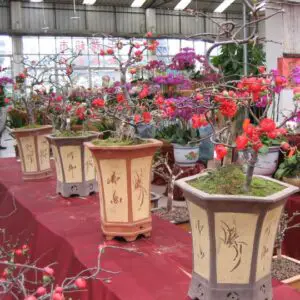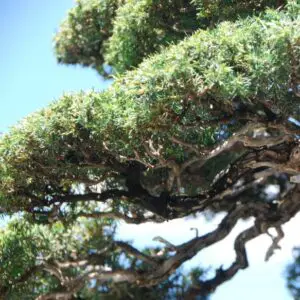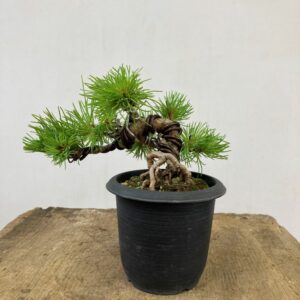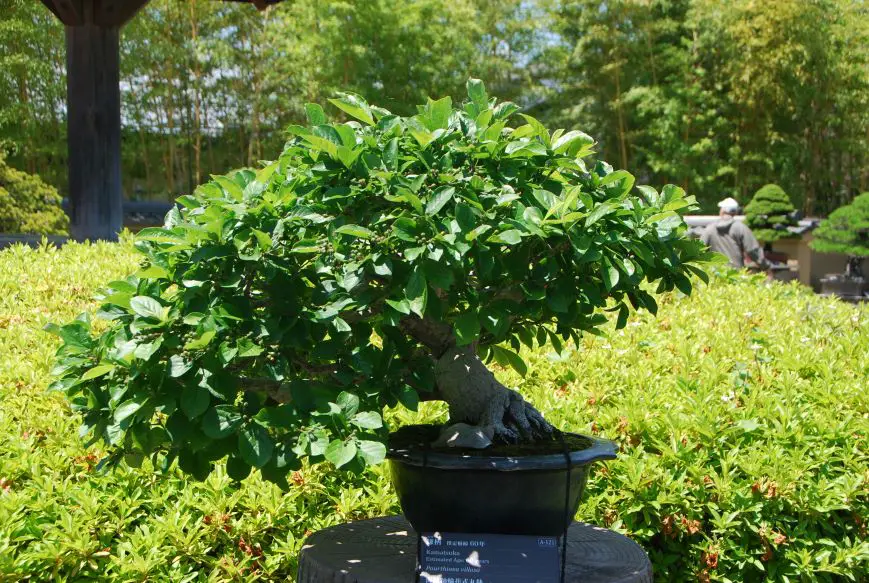You can create bonsai without applying wire through techniques such as clip and grow, guy wires and weighing, although precise control over tree shape and design proves to be challenging.
Wire-free bonsai: Is it possible?
Techniques for wire-free bonsai
It is possible to create bonsai without using wire. While wiring allows possibilities of vast manipulation of tree shapes, it is not the only technique available.
Here are a few methods you can apply to shape bonsai trees without wire, besides ordinary pruning techniques.
Clip and grow

Penjing bonsai
The clip-and-grow technique involves allowing the branches/trunks to grow freely and then trimming them back hard to create a certain movement in a tree.
To do this, first, you need to prune a trunk or branch just above a new trigger shoot where you want a new direction. Then, you let the new shoot grow in size as well as in length until it reaches the same dimensions from which it sprouted. When it grew to the size you want, it’s time to prune back radically.
This allows the creation of a natural extension of the tree with a flowing trunk line, realistic branch movement and a tapering structure. By repeating this process while choosing the direction of tree growth, you can control and create the shape of the tree.
This method of creating bonsai is used particularly by Penjing bonsai growers (Chinese bonsai) where the use of wires and artificial means of tree shaping is rejected in order to preserve the natural appearance and qualities of the tree.
Guy wires
The guy wire technique uses wires to gently pull down branches or the trunk of a tree into desired positions over a period of time, instead of wrapping them with wire. You can also use strings or cables as well to attach them to a stable part of the tree or the bonsai pot to create tension.
Weighing
Another method of wire-free bonsai is using weights to bend and shape the branches. By attaching weights to the branches, you can encourage them to grow in a particular direction. Over time, the branches will adapt to the weight and maintain the desired shape.
Benefits and challenges of wire-free bonsai

Benefits of wire-free bonsai
Like any bonsai technique, wire-free bonsai has its own set of benefits and challenges. In this section, I will explore the pros of practicing wire-free bonsai.
Natural appearance
Wire-free bonsai allows the tree to grow and shape itself naturally, resulting in a more organic and authentic appearance. It can preserve the qualities of the tree rather intact and appreciate its beauty as it is without intervening and artificially enhancing it.
Less technique involved
Techniques involved in wire-free bonsai are simple and less complicated, while knowledge of pruning and understanding of the tree’s growth patterns are necessary.
Good for tree health
Bonsai without heavy wiring places a greater emphasis on the health of the tree. At the end of the day, wiring is stressful to the tree however you do it. You can be very careful and experienced but still wiring can kill the tree.
Wire-free bonsai ensures good overall tree health, which contributes to the long-term well-being of your bonsai trees.
Challenges of wire-free bonsai
Purpose of wiring

Wiring Japanese white pine
Before diving into the challenges of wire-free bonsai, let’s talk about the purpose of wiring a bonsai tree. There are reasons why people use the wiring technique for bonsai creation. Wiring in bonsai serves two purposes:
- Create a desired shape in perfection
- Keep miniature size
Create the desired shape
The primary purpose of wiring is to make a bonsai tree into a desired shape precisely by bending branches and trunks. This can introduce interesting curves, twists and contours which add a distinctive character to the tree.
Wiring provides immediate and effective control over the placement and orientation of branches and trunks, enabling you to achieve a specific design vision for your bonsai.
Keep miniature size
Another purpose of wiring is to keep the tree size small.
When a tree is stressed, it makes a plant hormone that induces the aging of trees. Wiring stress can inhibit a tree from continuously growing upwards and promote fine branches to develop and the trunk to thicken. A bonsai tree may mature without full growth by wiring.
Challenges of wire-free bonsai
People use the bonsai wiring technique for the reasons discussed above and wire-free bonsai faces some challenges without using it.
Limited control over shape and design
Without using wire, you have less control over branch/trunk positioning and shaping. You can pull branches and trunks in one direction using string or weights but you cannot create movements within a branch freely.
Certain complex shapes or precise branch placements are more challenging or sometimes impossible to attain. Wire-free bonsai thus can result in a less refined design of the tree.
Limited styling options
Some bonsai styles, such as cascade, may be more challenging to achieve without using wire. These styles often require precise positioning and control over branches that wiring facilitates.
Longer development time
Training a bonsai without wire often requires a longer period of time. Clip and grow technique, in particular, rely on the tree’s natural growth patterns and may take several growing seasons or more to achieve the desired size and form, with branches reaching out sometimes a dozen feet (several meters).
If I had to guess, it would take twice as much or more for wire-free bonsai to make a similar shape as bonsai trees using the wire technique. So, from a small nursery tree to bonsai, it may take well over a decade to have a satisfying shape.
Less suited for coniferous trees
Wire-free bonsai is particularly suitable for deciduous trees and less suitable for coniferous trees.
The clip-and-grow technique relies on the tree’s ability to produce new buds along the pruned branches. Trees with a high back budding ability, such as many deciduous species, can develop new growth and ramifies more readily.
In contrast, tree species with limited back budding ability, such as Japanese black pine, may not respond as effectively to this technique. Coniferous trees can certainly be trained without wire but it needs special knowledge and technique for doing so.
More difficult to keep a miniature size
One of the “techniques” to keep a normal tree small is giving stress by wiring. Choosing wire-free may be good for your tree’s health but can potentially pose some challenges to keeping the size small.
If you are interested in how bonsai trees stay small, please check the following post.
My thoughts on wire-free bonsai…
Ultimately, the decision to create bonsai with or without wire depends on the species of the tree you want to make, your preference for the overall aesthetic of the tree, and the level of control and detail you seek in your bonsai tree.
A combination of techniques, such as selectively using wire for key branches and relying on just pruning or clip and grow for the majority of shaping, may be a good idea to strike a balance between control and natural growth.



